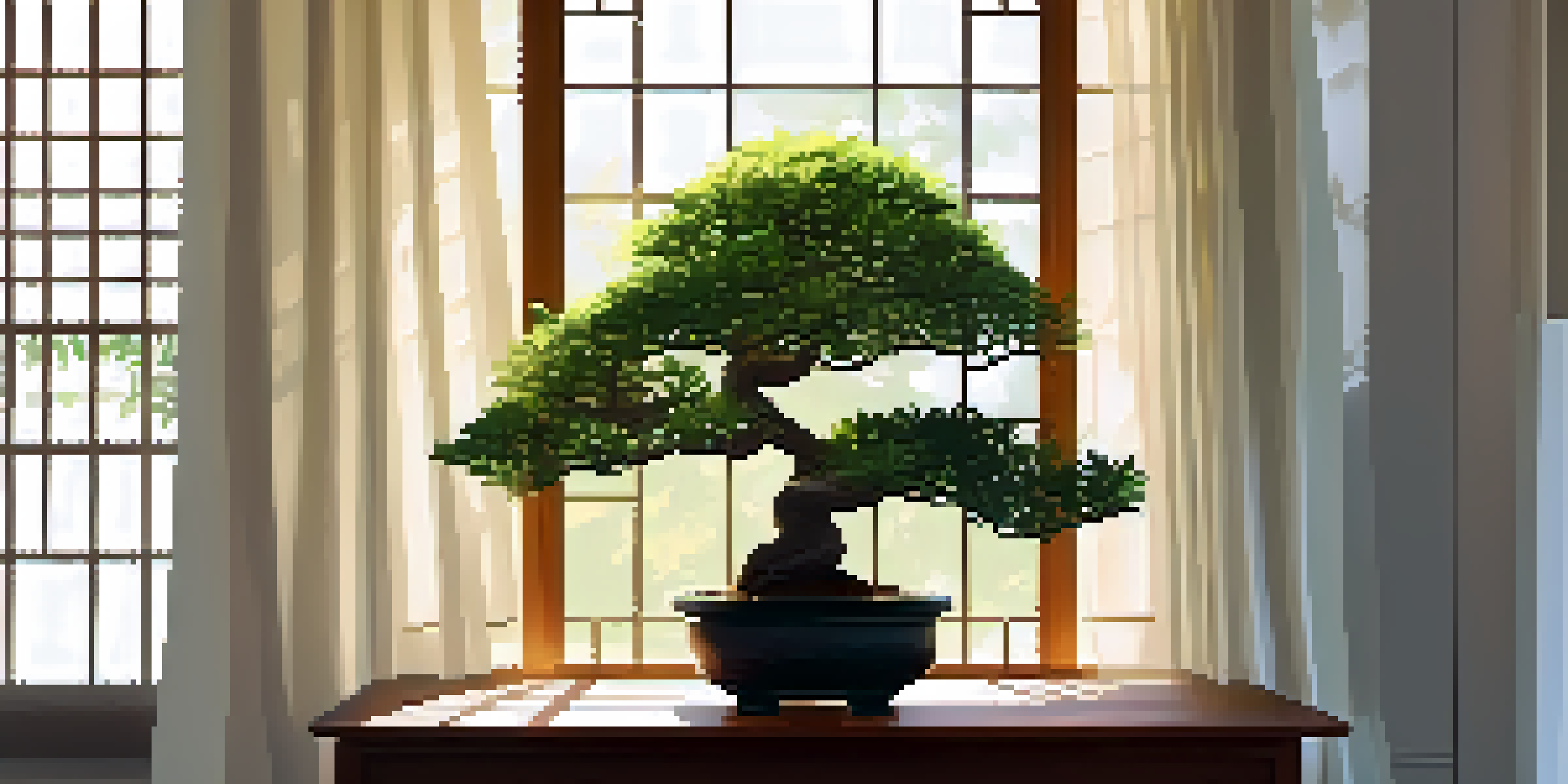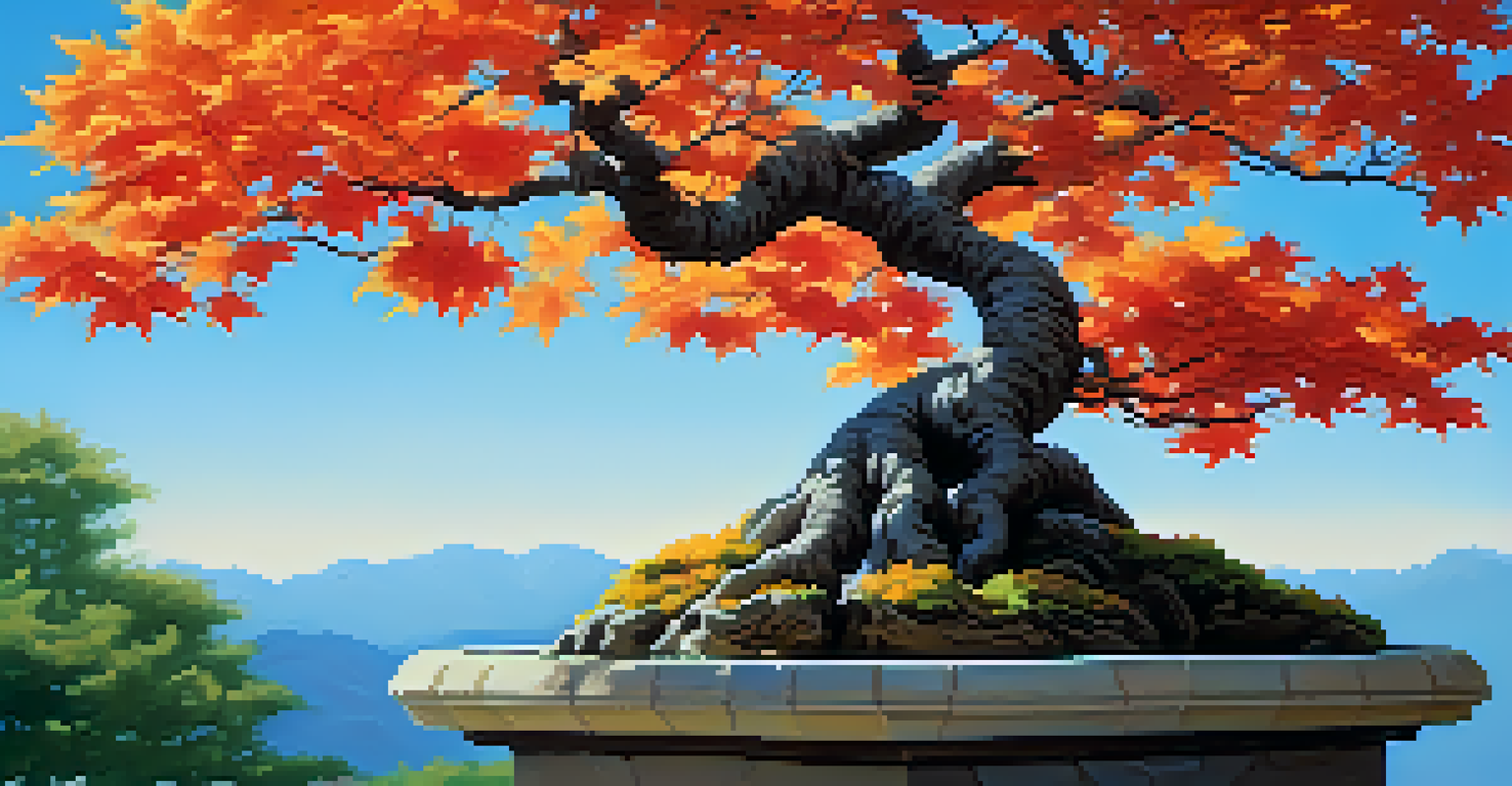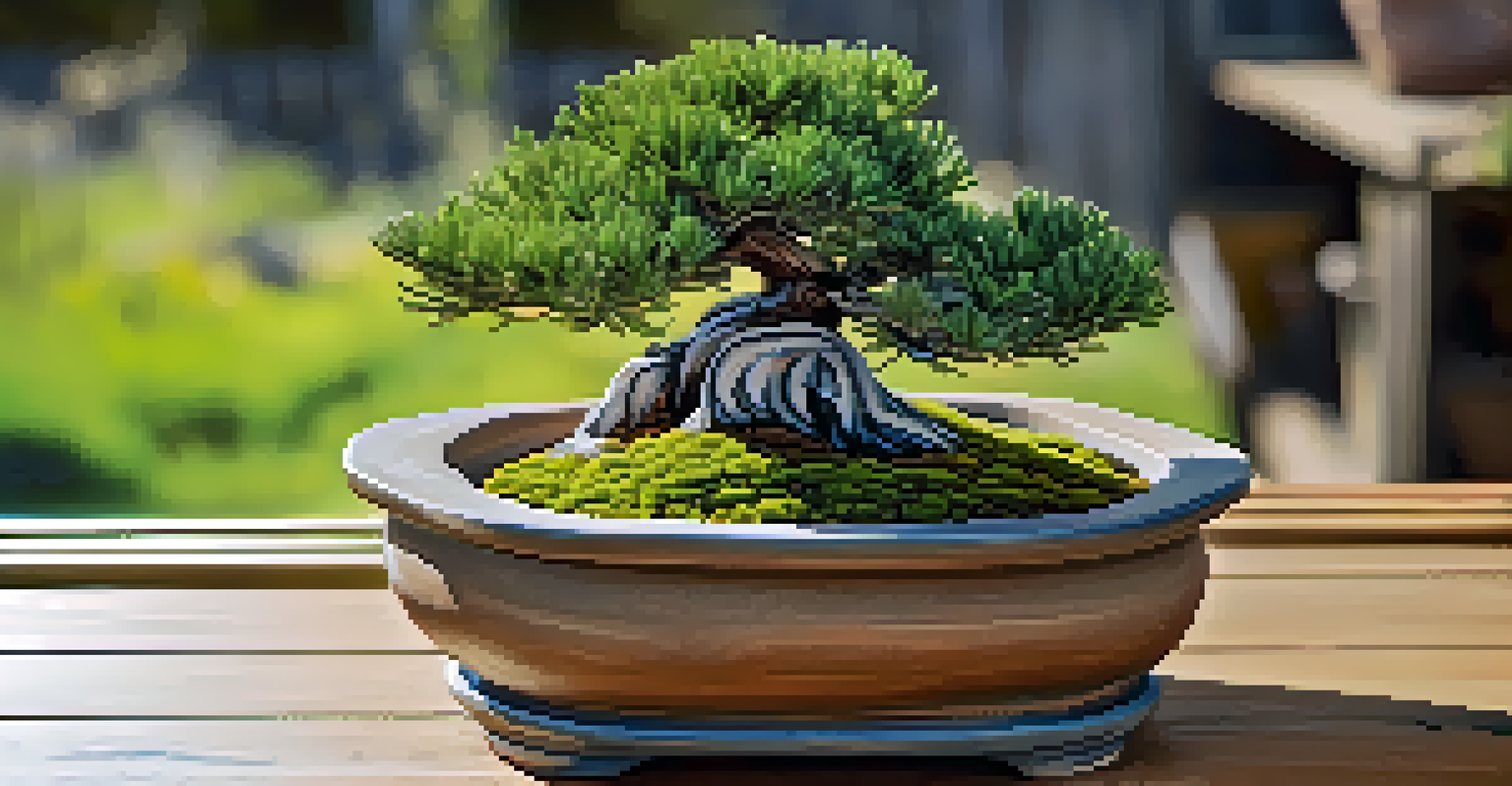Light Requirements for Different Types of Bonsai

Understanding the Basics of Light for Bonsai Trees
Light is a crucial component for the health of bonsai trees, as it directly influences their growth and vitality. Each species has specific light requirements that can vary from low to bright indirect light. Knowing these needs helps ensure that your bonsai not only survives but thrives in your care.
Plants are like people; they thrive in environments that meet their needs.
In general, bonsai trees require anywhere from 4 to 8 hours of light daily, depending on the species. For instance, tropical bonsai varieties like Ficus prefer bright, indirect light, while others may tolerate lower light levels. Understanding these basic needs can pave the way for a flourishing bonsai garden.
It's also important to consider the quality of light, as not all light sources are created equal. Natural sunlight is typically the best option, but you can supplement with grow lights if needed. This way, you can mimic the natural conditions that your bonsai would experience in their native environment.
Light Requirements for Tropical Bonsai Species
Tropical bonsai trees, such as Ficus and Jade, thrive in bright, indirect sunlight. These species are accustomed to the warm, sunny environments of their native habitats, so they require ample light to maintain healthy foliage and growth. Placing them near a south-facing window is often ideal.

While they enjoy plenty of light, it's essential to avoid direct sunlight, especially during the hottest parts of the day. Too much direct sun can scorch their leaves, leading to damage. Instead, filtered light or indirect sunlight is the perfect balance for these tropical beauties.
Light is Essential for Bonsai Health
Understanding and providing the right light conditions is crucial for the growth and vitality of bonsai trees.
If you notice your tropical bonsai becoming leggy or dropping leaves, it might be a sign that it’s not getting enough light. Adjusting its location or using grow lights can help revive it. Regularly observing your plant will let you tweak its light exposure for optimal health.
Light Needs for Deciduous Bonsai Trees
Deciduous bonsai trees, like Maple and Elm, have unique light requirements that change with the seasons. During the growing season, they thrive in bright, direct sunlight, which supports robust leaf growth and vibrant colors. A sunny outdoor spot can work wonders for these trees.
The best time to plant a tree was 20 years ago. The second best time is now.
As winter approaches, however, these species enter a dormant phase and require less light. Placing them in a slightly shaded area can help them rest without the stress of excessive light. Understanding this seasonal shift is key to ensuring their health year-round.
If you notice your deciduous bonsai losing leaves prematurely, it might be a sign of insufficient light. Regularly assessing your tree's condition can help you adjust its light exposure, ensuring it gets what it needs during every stage of its life cycle.
Light Requirements for Coniferous Bonsai Trees
Coniferous bonsai species, such as Juniper and Pine, prefer bright light conditions and usually do well in full sun. These hardy trees are adapted to withstand direct sunlight, making them ideal candidates for outdoor placement. A location that receives 6 to 8 hours of sunlight is often best.
However, while they love light, it's important to monitor their moisture levels, especially in hot weather. Too much sun can dry them out quickly, leading to stress. Balancing light exposure with adequate watering is crucial for keeping your coniferous bonsai healthy.
Different Species Need Different Light
Each bonsai species has unique light requirements, ranging from low-light tolerance to a preference for bright, direct sunlight.
If you notice browning or needle drop, it may indicate that the tree is either too dry or not getting enough light. Regularly checking the soil moisture and adjusting the light exposure can help you maintain the right balance, ensuring your conifer thrives.
Identifying Low-Light Bonsai Species
Not all bonsai trees thrive in bright light; some are well-suited for low-light environments. Species like Serissa and Chinese Elm can adapt to shadier conditions, making them perfect for indoor settings. These trees can still flourish with about 4 to 6 hours of indirect light each day.
Choosing the right location in your home is essential for these low-light bonsai. A north-facing window or a well-lit room with filtered light can provide the right conditions for growth. Regular rotation can also ensure that all sides receive adequate light.
If you notice slow growth or pale leaves, it may be a sign that your low-light bonsai isn’t getting enough light. Adjusting its placement or adding supplemental lighting can help revitalize it. Keeping an eye on your tree's response to light will guide you in providing the best environment.
Understanding Seasonal Light Changes
As seasons change, so do the light conditions for your bonsai. In spring and summer, the sun is stronger and days are longer, providing ample light for growth. However, as fall approaches, the intensity and duration of sunlight can decrease, impacting your tree's needs.
During this transitional period, it’s vital to adjust your bonsai’s placement accordingly. Moving your tree to a sunnier spot can help ensure it continues to receive the necessary light for healthy growth. Noticing how the light shifts will help you make informed adjustments.
Adjust Light Based on Seasons
Seasonal changes affect light availability, so it's important to adjust your bonsai's light exposure accordingly throughout the year.
In winter, many bonsai enter dormancy, requiring less light. However, some species, especially tropical ones, still need a bit of light to stay healthy. Monitoring your bonsai's condition and making seasonal adjustments can help maintain its well-being throughout the year.
Using Artificial Light for Indoor Bonsai
For those who keep bonsai indoors, artificial light can be a game-changer. Grow lights can provide the necessary spectrum of light to support healthy growth, especially in low-light environments. They can be a fantastic supplement for species that need more light than your home can provide.
When selecting a grow light, consider factors like intensity and duration. LED lights are popular due to their efficiency and ability to mimic natural sunlight. Positioning the lights correctly—about 12 to 24 inches above your bonsai—ensures adequate light without overheating the plant.

Regularly observing your bonsai's response to artificial light is crucial. If you notice signs of stress, such as leaf drop or leggy growth, it may be time to adjust the light duration or intensity. Finding the right balance will help your indoor bonsai thrive.
Conclusion: Tailoring Light for Your Bonsai Collection
Caring for bonsai involves more than just water and soil; light is a vital component that can make or break your tree's health. By understanding the specific light requirements for different species, you can create an optimal environment for each of your bonsai. This tailored approach leads to thriving plants that bring joy to your space.
Remember that observation is key. Monitor your bonsai's health regularly and be ready to make adjustments based on their unique light needs. Whether you have tropical, deciduous, or coniferous species, each tree will respond differently to light exposure.
In the end, nurturing your bonsai is a journey of learning and adaptation. With the right light conditions, your bonsai can flourish, providing beauty and tranquility to your home for years to come.